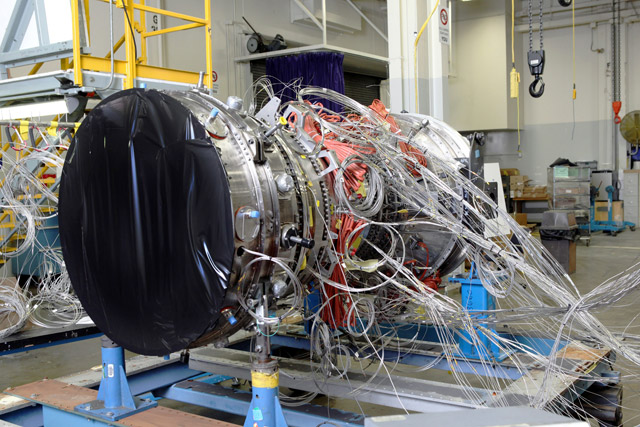If a new kind of engine technology called an adaptive turbofan works for the next supersonic fighter, the military will have today's booming commercial aircraft market partly to thank.
New analytical results show that several commercially-derived technologies inserted into the core of General Electric's adaptive turbofan ground test engine (Advent) worked better than expected in tests performed last February.
Although the baseline figures are classified, GE says the high-pressure turbine stage ran 10˚C (50˚F) hotter than the temperature goal set by the US Air Force Research Laboratory, and it operated at that elevated state for 10min longer than required.
An upcoming test in the fourth quarter of this year will check out the adaptive part of the GE engine, but the activity in February validated that the technologies borrowed from today's commercial engines actually exceed the air force's performance requirements.
 |
|---|
GE |
"We basically took GE's commercially-developed technology and applied it and proved that it in fact met the military customer's needs," says Dan McCormick, the company's Advent programme manager.
To meet commercial requirements for ever-improving fuel efficiency, GE's newest turbofan engines are operating at hotter temperatures than ever before. The CFM International Leap engine family will be the first to use ceramic matrix composites to cope with the higher temperatures in the hottest section of the engine aft of the combustor. GE is now repurposing the CMCs for the military market with the Advent programme.
Another commercial technology embedded in the Advent core includes a new die casting process that allows GE to insert more interior cooling passages in each turbine blade, allowing the metallic structures to survive in temperatures that would otherwise cause them to melt, McCormick says.
Now that the engine core tests are complete, the next step is to assemble and run a full-scale engine with the adaptive fan technology.
An adaptive fan adds a third stream of airflow that bypasses the engine core. Opening the third stream raises the engine's bypass ratio, which improves fuel efficiency but limits maximum airspeed. Closing the third stream allows the engine to run at top speed. Having the auxiliary airflow also helps with cooling the turbine section, as airflow can be extracted from the compressor and cooled in the third stream before being reinserted into the turbine section.
Most of the hardware for the first complete Advent engine test is already delivered and is now in assembly, McCormick says. The tests will be complete in the fourth quarter.
The Advent programme will be succeeded by the advanced engine technology development programme, for which both GE and Pratt & Whitney are designing a follow-on engine with a third-stream airflow and highly efficient core. The AETD programme will conclude at the preliminary design review milestone of a production-ready engine with adaptive fan technology at the end of fiscal year 2016.
At that point, the military will have to decide whether it needs a new engine technology. The adaptive fan has been considered for sixth-generation fighters on the drawing boards for the US Air Force and US Navy. It has also been discussed as a mid-life update for the Lockheed Martin F-35.
Source: Flight International























